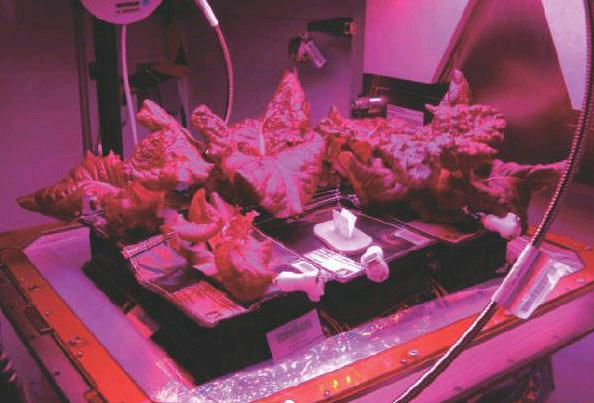走,去太空烤个面包!
2017-11-15
想想看,如果宇航員能在太空烘焙面包,也不失为一件幸福的事。对于视面包如命的德国人来说,就更是如此了。尽管困难重重,不过这样的美梦即将实现,因为有个为宇航员着想的贴心德国人开启了太空面包烘焙计划。让我们拭目以待吧!
Crumbs1) may seem harmless here on Earth, but they can be a hazard in microgravity2) — they could get in an astronaut's eye, or get inhaled3), causing someone to choke4). Crumbs could even float into an electrical panel, burn up5) or cause a fire.
That's part of the reason why it was a very big deal in 1965 when John Young pulled a corned beef6) sandwich out of his pocket as he was orbiting the earth with Gus Grissom.
"Where did that come from?" Grissom asked Young.
"I brought it with me," Young said.
Young took a bite and then microgravity took over, spreading bread crumbs throughout the spacecraft.
Today, instead of bread, astronauts usually eat tortillas7): They don't crumble in the same way and they're easy to hold with one hand as the astronaut floats about.
But for many Germans, tortillas just don't cut it8). So when a man named Sebastian Marcu heard that German Astronaut Alexander Gerst is returning to the International Space Station in 2018, that got him thinking: "Shouldn't we do something to enable him to have fresh bread in space?"
Bread is a really big deal in Germany—there are thousands of variations of different kinds of bread there. To Marcu, a German astronaut in space without fresh bread seemed like a preventable problem.
Marcu was working in the space sector, and he and his friend, an engineer, started a company called Bake in Space in March 2017.
They're partnered with the German Aerospace Center, which is basically Germany's NASA. Their goal is to make an oven that can successfully bake dough on the International Space Station by 2018.
But there are a lot of obstacles that make baking in space difficult.
First, the oven needs to function on about a tenth of the power an oven here on earth does. And it's pretty much impossible to preheat the oven, because if it gets hot and then the door is opened, a giant hot air bubble could leave the oven and float into the spacecraft.
"It could just sit there in mid air and an astronaut could basically burn himself if he flies through it," Marcu says.
Which is clearly not ideal.
Then there's the problem of the dough—at low heat, bread has to bake for a longer period of time, but the longer it bakes, the drier it gets. And crumbling must be avoided at all costs because of the havoc9) bread wreaks10) in space.endprint
Despite all the technical challenges, Marcu predicts that his company will be able to have Alexander Gerst bake the first loaf of bread in space next year.
"It's not just about making one German astronaut happy with fresh bread," Marcu explains. "There's really a deeper meaning to bread in space."
He says bread is ubiquitous. It's made its way onto our dinner tables, into our religion, our slang. Breadwinner and dough stand for money, for wellbeing, for quality of life. We break bread with strangers as a gesture of good faith.
"Well, it would definitely be a big symbol of peace to break bread with an alien life form I think," he says.
But most importantly to Marcu, freshly baked bread in space will offer astronauts a little slice of home.
在地球上,面包屑似乎并無害处,但在失重情况下,面包屑却是危险品——它们能进入宇航员的眼里,或是被吸入口鼻引起呛咳。面包屑甚至能飘进配电板里,烧毁配电板或引起火灾。
这就是为什么在1965年,当约翰·杨和加斯·格里森在宇宙飞船上绕地航行的时候,杨从口袋中掏出一块腌牛肉三明治是一件非常严峻的事情。
“这东西从哪儿弄的?”格里森问。
“我带上来的。”杨回答说。
杨咬了一口三明治,然后微重力就控制了一切,使面包屑飘到了宇宙飞船的各个角落。
如今,宇航员们一般不吃面包,而是吃墨西哥玉米薄饼。这种饼不像面包那样掉屑,而且它们也利于宇航员在飘行的时候用一只手抓握。
但对很多德国人来说,墨西哥玉米薄饼并不合心意。所以,当一个名叫塞巴斯蒂安·马库的人听说德国宇航员亚历山大·格尔斯特将于2018年返回国际空间站时,他不由想到:“难道我们就不能想想办法,让他在太空中吃到现烤的面包?”
在德国,面包可不是件小事儿——这里有成千上万种面包。在马库看来,德国宇航员在太空中吃不到现烤面包这个问题,似乎是可以避免的。
马库从事太空行业,他和他的一位工程师朋友在 2017年3月成立了一家名叫太空烘焙的公司。
他们与德国航空航天中心(基本就相当于德国的NASA)一起合作,目标是在2018年之前制作出一种可在国际空间站上成功烤出面包的烤箱。
但是,要在太空烤面包,困难重重。
首先,这个烤箱的功率只能约是地球上烤箱的十分之一。而且预热烤箱几乎不可能,因为在烤箱预热之后,一开烤箱门,就会有一个巨大的热气泡跑出来,飘到飞船里。
马库说:“这个气泡会就那样停留在半空,宇航员飞过气泡的时候基本上会被烫伤。”
这显然不够理想。
接下来还有面团的问题——在低温下,面包必须烘烤更长的时间,但是烘烤的时间越长,面团就会变得越干燥。而出现面包屑这种情况是必须不惜一切代价避免的,因为面包屑在太空中会带来巨大灾难。
尽管面临种种技术难题,马库预计,他的公司明年能让亚历山大·格尔斯特在空间站成功烤出第一个面包。
“这不仅仅关系到一位德国宇航员能否心满意足地吃上新鲜面包的问题,” 马库解释说,“在太空烤出面包其实还有更大的意义。”
他说,面包是随处可见的东西。它走上了我们的餐桌,进入了我们的宗教、俚语。“挣钱养家的人”和“面团”象征着钱,象征着幸福,象征着生活品质。我们会把跟陌生人分享面包当做一种善意的举动。
“这么说吧,我觉得,要是我们能跟外星人分享面包,那绝对是和平的一大象征。” 他说。
不过,在马库看来,最重要的是,新鲜出炉的太空面包会给宇航员带来一丝家的温暖。
2015年8月10日,美国宇航局(NASA)官网公布了一组图片,称生活在国际空间站内的宇航员们首次品尝了他们在太空失重环境下种植出来的紫叶生菜。NASA官方表示,此次的VEGGIE (素食者)计划是NASA首次尝试在太空中栽培出供应宇航员食用的农作物,它标志着该空间站蔬菜培育试验取得阶段性成功,也可看做是载人飞船前往火星的行程中又迈出了重要一步。
“If we're ever going to go to Mars someday, which we will, but whenever that is, we're going to have to have a spacecraft that is more sustainable in terms of food supply. On the way to Mars, and on the way back, we won't be able to get resupplies. We will have to be completely self-sufficient. Having the ability to grow our own food is a big step in that direction.”
—Scott Kelly (美国宇航员)
早期载人航天事业发展阶段,食品都被制成牙膏状,以挤压的方式食用。后来飞行试验发现失重条件下并不影响食物吞咽,所以对太空食物进行了改善。
如今的太空食品总共有五大类:复水食品(主要以汤和早餐食品为主。复水食品是事先经过脱水处理,进食前必须再向食物中注入一定量的水)、热稳定食品(指经过加热杀菌后保存在罐子里或封装在柔性袋内的肉食和鱼)、中等湿度食品(如桃干、梨干等果脯)、辐照食品(指经过辐射灭活和杀菌的食品)和天然食品(指没经过处理的食品,如水果、酱料等)。
因此,不论是欧美还是中国,宇航员们的饮食都得到了很大的改善。在如今中国宇航员的一日三餐中,还包括宫保鸡丁、鱼香肉丝、土豆牛肉、香辣豆干等菜肴,他们甚至还品上了茶。
1. crumb [kr?m] n. 食物碎屑;面包屑;糕饼屑
2. microgravity [?ma?kr?? ?ɡr?v?ti] n. 微重力(指由弱引力引起的失重状态)
3. inhale [?n?he?l] vt. 吸气;吸入(烟等)
4. choke [t???k] vi. 呛到;窒息
5. burn up: 烧毁
6. corned beef: 腌牛肉,用盐水和其他调料腌制的牛肉,通常以罐头的形式售卖。
7. tortilla [t???ti??] n. (用玉米面和鸡蛋制成的)墨西哥玉米薄饼
8. not cut it: (问题的解决办法)不令人满意
9. havoc [?h?v?k] n. 大破坏;大混乱
10. wreak [ri?k] vt. 造成(混乱或破坏)endprint
